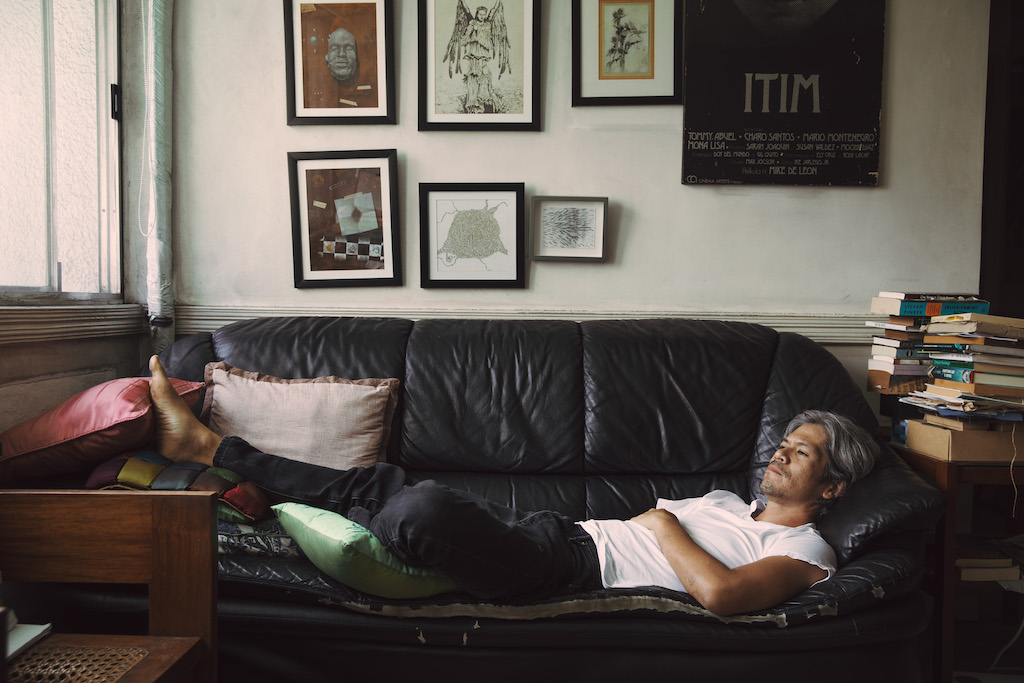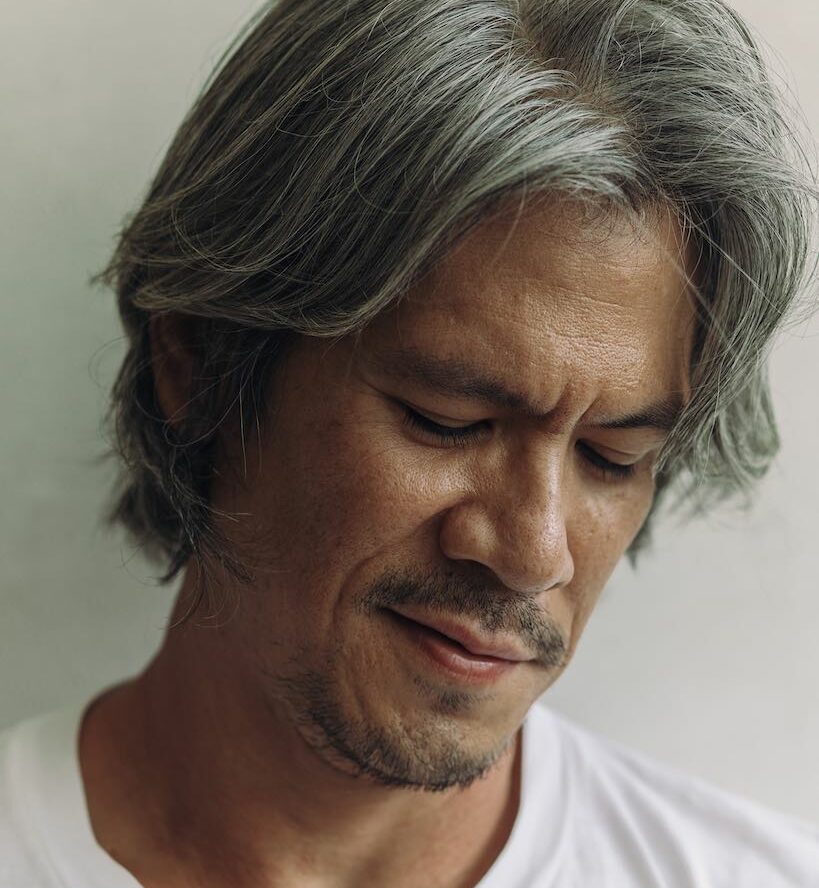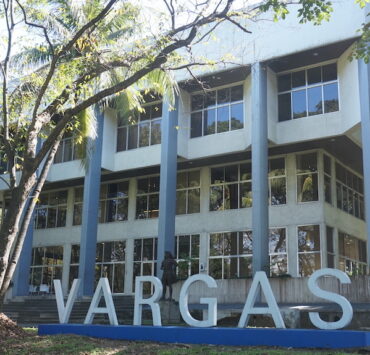A formidable record stash, distinct and tilted artwork, a shoe corner with around fifty pairs—“tambakan ng bagay” is how Erwin Romulo describes his house. A dumpsite, if one translates ungenerously, but a dumpsite of meaning.
Morrissey peers over the living area from a poster. A Wonderboom™—the New York Times’ pick for best portable bluetooth speaker—follows Erwin wherever he needs sound. Inside his study, History, Politics, Philosophy books are stacked inside steel shelves. Three people are crammed into a club chair, watching pigs get slaughtered.
It’s footage of sausages, both completed and in-production, with religious text as absurd commentary. “THIS IS MY BODY WHICH SHALL BE GIVEN UP TO YOU,” it says, against the image of a pig corpse and a video of Vienna sausages in a rotating saucer. I whisper to ask if there is context behind this exercise, Erwin answers, “Wala. Panoorin niyo lang.” Minutes later, after many scenes of pig brutality, pork processing, and religious iconography, the screen displays a word: “SUSEJ.” According to Erwin, it’s an underground classic of the moving picture art genre made by new media artist Tad Ermitaño, long before people were declared persona non grata for using the religious language in art.
No one can describe Erwin Romulo—not even himself. But in a pitch video for an exhibit he’s curating, which he showed before SUSEJ, he makes a valiant attempt: “My name is Erwin Romulo,” he begins. “I am a filmmaker, writer, and art curator. I have also been many other things in my career. I have edited magazines and books. I’ve composed and produced music for rock bands and even for the ballet. I’ve scored and sound designed films, including one that ran for over eight hours.”
[READ: Lav Diaz on why he makes long films set in the past]He is all the tiring verbal crutches writers use to describe those who do so much—creator, multi-hyphenate, renaissance man—because anything more specific feels inaccurate, and anything less feels diminishing.
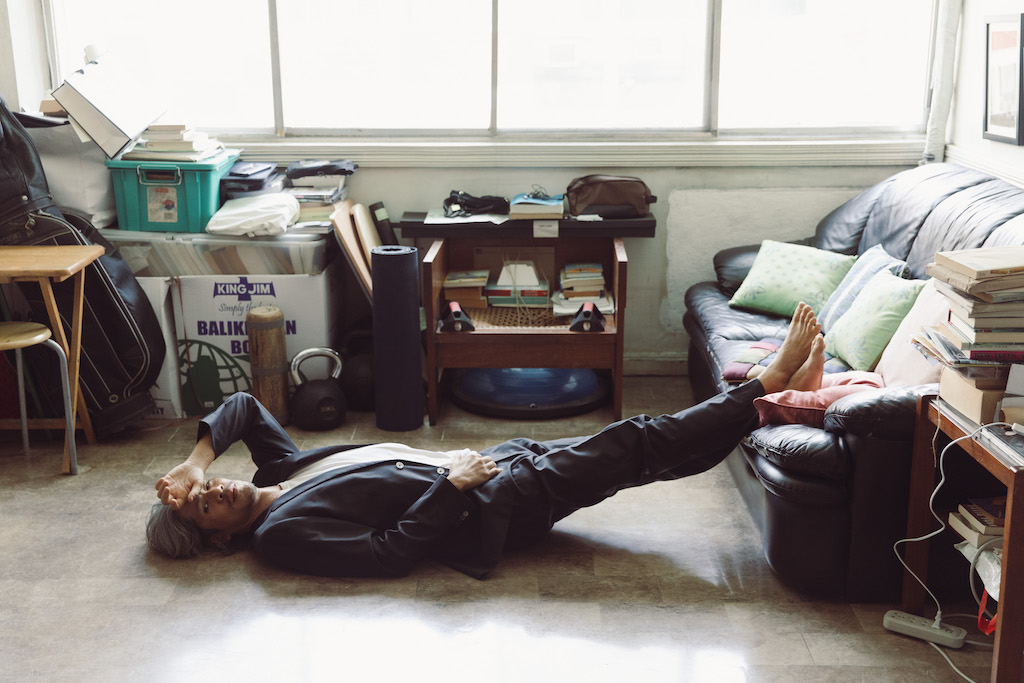
Erwin’s work has been memorable and voluminous. He was the founding editor-in-chief of Esquire Philippines during its most interesting and provocative years. One might recall him reconnecting the Eraserheads, which led to them recording their first new music in more than a decade. He’s composed for a number of blockbuster films, including Erik Matti’s “On the Job.” He curated a timely experiential exhibit about President Rodrigo Duterte’s drug war for Art Fair Philippines in 2018—among several other projects.
Nevertheless, Erwin is impossible to label, perhaps owing to his wildly multi-disciplinary inclinations. He is all the tiring verbal crutches writers use to describe those who do so much—creator, multi-hyphenate, renaissance man—because anything more specific feels inaccurate, and anything less feels diminishing.
“Alam mo ba kung gaano kahirap kang i-research?” I tell him. His profile, art practice, and extensive oeuvre elude the casual Google search. With the right keywords, one might perceive Erwin the Writer, Erwin the Composer, or Erwin the Curator, and so on. But Erwin Altogether—not possible. Ask enough people about Erwin Romulo and you will hear many say he is intelligent, visionary, and provocative—but they will also ask: “What does he do, actually?”
Which led me to suspect that this was a clever long-term ruse orchestrated by Erwin himself. So I ask him, “Sinasadya mo ba ‘to?”
“HINDI,” he replies. “Ang ganda sana kung sinasadya ko.”
“Most friends don’t know what I do,” Erwin says. “If you ask them ‘What does Erwin do?’ They don’t know, which I, for the longest time, was really offended by. REALLY offended by.”
Erwin talks with clarity and repetition. He will say certain things again—and you can hear the verbal all-caps on certain words. REALLY hear them. Repetition sometimes sounds like instruction, but Erwin’s repetition feels more like a byproduct of excitement, playfulness, and wanting you to get the full story. “You don’t understand,” I imagine him saying. “There is no other way to tell this story.” As if a place existed inside him, and unless he says his words a certain way, the place cannot exist inside you.

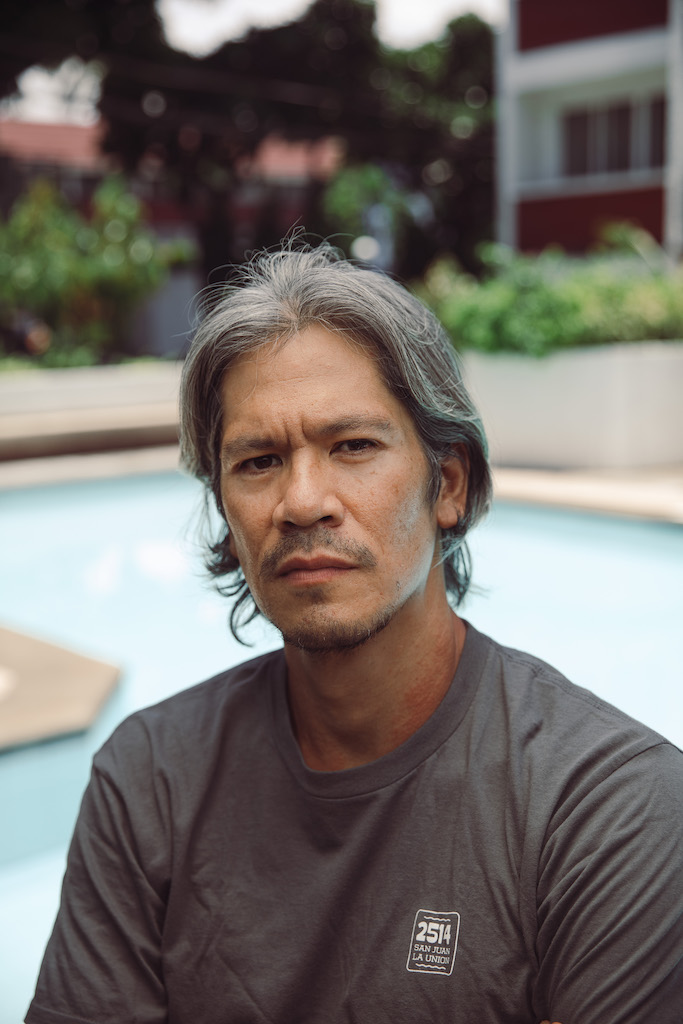
“I had a project for the Department of Tourism—it was an (unpaid) ASMR project,” Erwin says. “We went to several locations in Luzon, Visayas, and Mindanao. I had an ambisonic mic, which takes 360-degree sound. Ang mandate ko, we had to go to the remotest locations na hindi pinupuntahan ng turista. The whole playlist is on YouTube.”
As he tells this story, Erwin plays ambient mountain sounds on the Wonderboom™. He talks about hiking up Mt. Amuyao for six hours before realizing they were too high up for there to be any sound at all. “As in ZERO. As in ZERO SOUND. We had to go like a few hundred meters down the mountain to plant mics. As in ZERO. Ang saya ‘di ba?”
An Erwin story is repetition and multimedia and the blunt force of a friend who thinks he can take you there if you just immerse in his words. One thinks: If he tries this hard to tell a single verbal story, it’s easy to imagine how hard he works on movie scores, articles, and art exhibits.
“I always say I’m a filmmaker that uses sound,” Erwin says. And his bias for sound seems to be one rooted in childhood.
All the writing I’ve ever done, when it’s done, it’s like a nightmare that’s temporarily stopped. Wala siyang relief eh, unlike music or exhibits [where] there’s an ending.
Erwin Romulo
The EDSA revolution is mostly remembered with images. Yellow ribbons, nuns with their arms linked, the dictator in black and white. But in Erwin’s head, it is sound—turmoil and tense silence. After the revolution, his father Alberto Romulo, President Cory Aquino’s first Budget Minister, brought 10-year-old Erwin to the Ministry of Budget to take over the office. “It was a madhouse,” Erwin says. “A hostile takeover. And I remember the sound, actually. Talagang basagan ng plato, sigawan. Every takeover was medyo violent.” Erwin’s suspicion was that he was brought as protection, that people would think twice about rioting with a little boy around. I wonder if we are what we naturally pay attention to in moments of high stress, because if so, Erwin the Boy paid attention to the sound.
“I remember it was really quiet. REALLY quiet,” Erwin says. “Kasi what was happening in the other departments [was] they were all being fired and new people were brought in. And remember, as much as we like to think ‘86 was all ‘People Power’, there were certain factions that just wanted to keep their jobs. So my dad and [Marcos’] Minister Alba came out and announced that everyone will keep their jobs.”
Erwin tells this story well, but perhaps if he could have planted an ambisonic mic right there, in the middle of the Ministry of Budget in 1986, he would have. He is enamored by such artifacts and what he could do with them. In 2017, he curated an experimental sound exhibit based on a sex tape between President Ferdinand Marcos and his American mistress Dovie Beams.
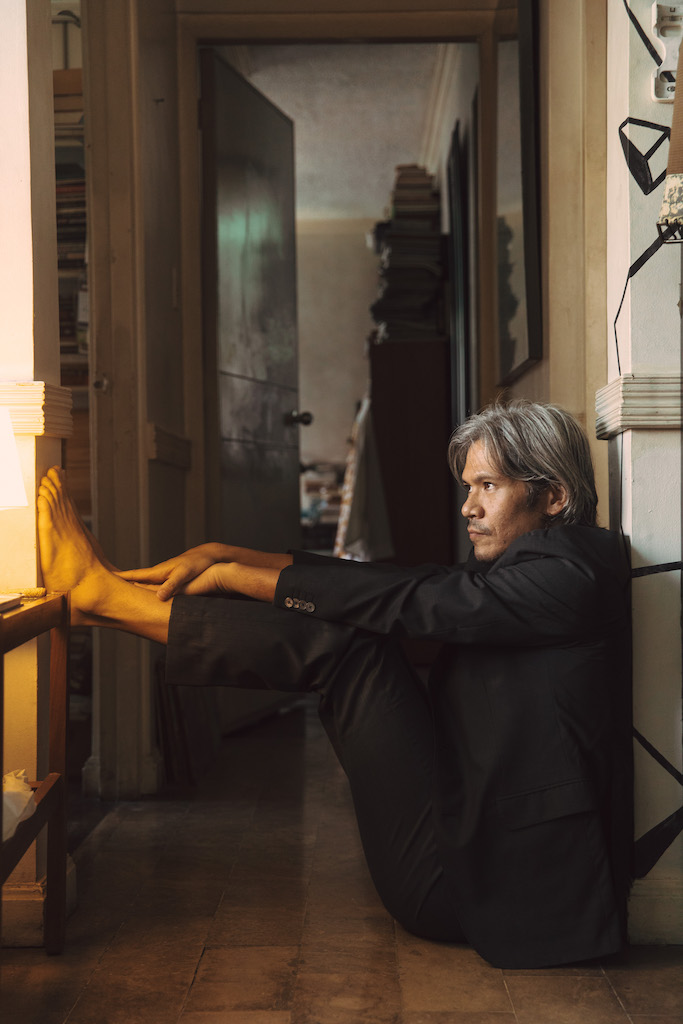
More recently, he has talked about putting up a record label. “It’s all obscure electronic music na modern composition,” he adds. And in a conversation replete with repetition, Erwin the Repeater says the one phrase he repeated the most often: “Walang ibang gagawa eh.”
Erwin’s projects can feel far apart from each other. One day he could be scoring an action flick, and the other he might be hiking up a mountain with an ambisonic mic just because someone told him it was “Sagada’s Evil Twin.” Then you might see him in the country’s biggest art fair manipulating a dictator’s sex grunts. But what unifies these projects—despite the distance in genres or disciplines—would be that feeling of almost-loss: “If we don’t do this, no one else will.”
This idea that motivates Erwin is also a clue to what might demotivate him: the fear that a project can be done by someone else anyway; that it is something anyone can think of and/or pull off. Art must always be somewhat exceptionalist, I can almost hear him argue. It feels like it’s what makes Erwin Romulo’s work across all genres so distinct. He is both the last puzzle piece, and the person who declared that this whole damn thing is a puzzle.
It doesn’t make it easier to describe him with a word, but there is an old poem called “Keeping Things Whole” by the late Mark Strand that might just describe his work best. It begins:
I am the absence
of field.
This is
always the case.
Wherever I am
I am what is missing.
Strand ends the poem thus: “We all have reasons / for moving. / I move / to keep things whole.”
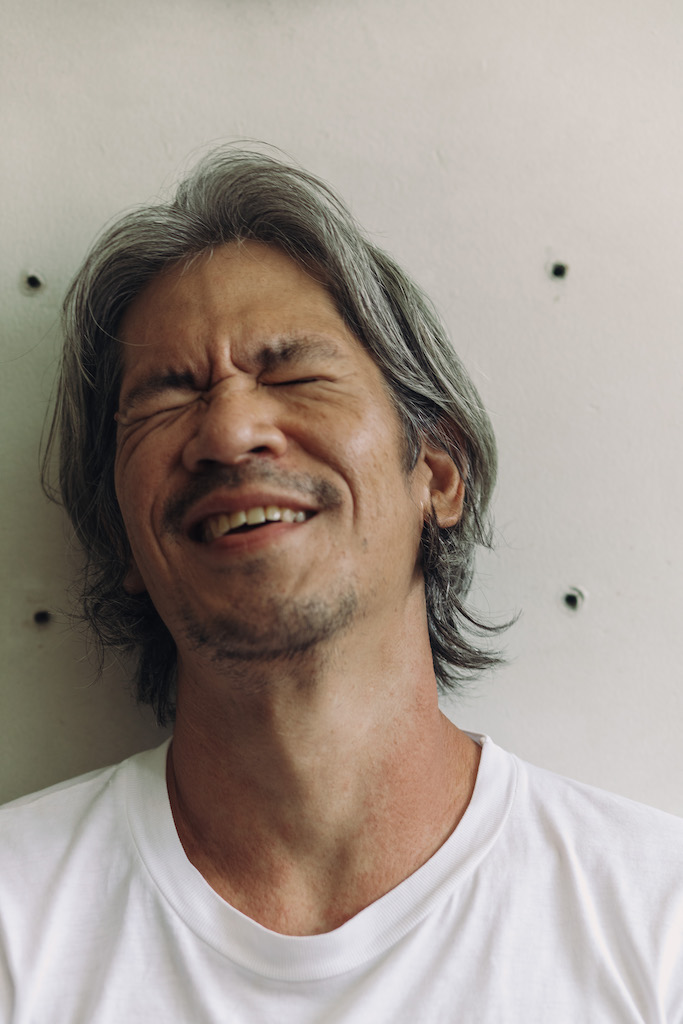
I still want to be a writer, but I don’t want to live in my head.
At 47, clarity comes easily for Erwin Romulo. “This is a new realization,” he says during the shoot. “I may be left-handed.”
He is more relaxed and easy-going, but still intense. “But if you look at all the stuff I show you, all of them have a sense of humor, ‘di ba?” he pleads. He is also happy with everything he’s writing now.
It is a claim I am not used to hearing from writers, said in a warm, serene tone that I am not used to hearing from writers. Which might be why I could only answer with “Wow. What changed?” And his answer was a simple one, too: “Saying no to things I didn’t want to do anymore. Less expenses, and more things I want to do. I got sick last year, so that kind of helped me refocus what I really want.”
“I have a protocol na, basically, I time it,” he continues. “Twenty minutes, I have to write and I can’t stand up. And when that’s done, twenty minutes I can’t be at the desk. I can’t watch videos, because that really breaks my focus when I start to watch stuff. But I can listen to music, read, and then I have to go back. Twenty minutes is a random number, but it’s worked.”
I ask Erwin, “So, was there ever an image you were trying to build for yourself?”
“It’s still writer naman talaga, ‘di ba?” he replies. “I still want to be a writer, but I don’t want to live in my head. I couldn’t imagine writing a novel, although I really want to. Kasi, unang una, you just have to live in your head. All the writing I’ve ever done, it’s like, when it’s done, it’s like a nightmare that’s temporarily stopped. Wala siyang relief eh, unlike music or exhibits [where] there’s an ending.”
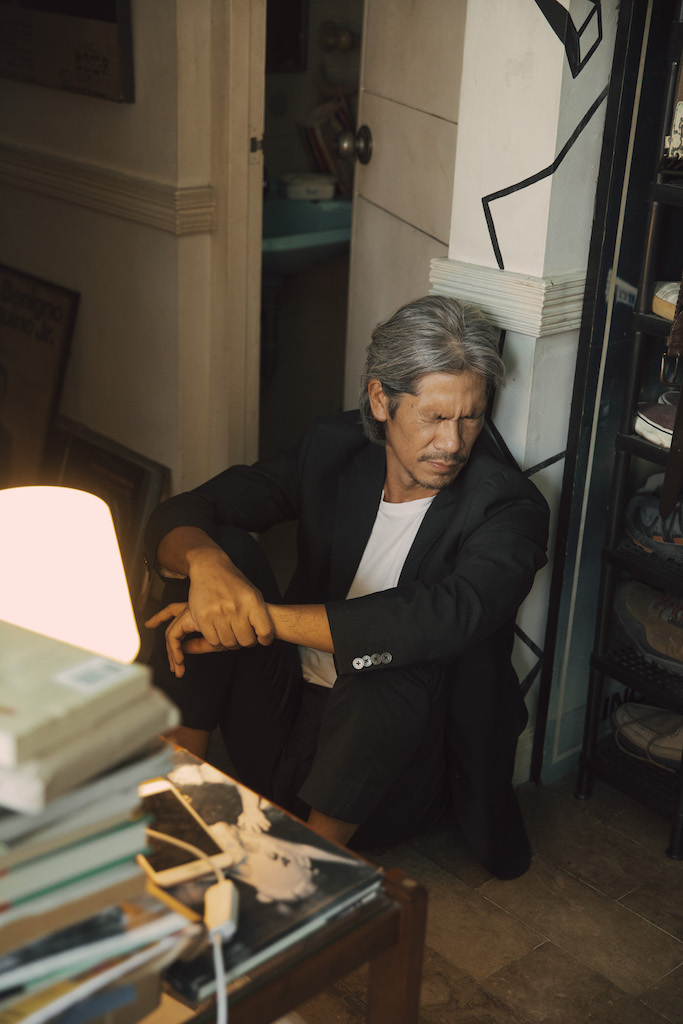
There is something sentimental about it—that it never stopped being “writer.” Erwin has always been a writer. He joined the Philippine Star in 1996 to write, won a Palanca Award for essay in 2004, and has continued releasing thoughtful writing. This is a man who has done artistic and cultural work that pays more and tortures less than writing—and “writer” is still what comes out of his mouth. As if to say, “I know it seems like I have a lot of choices, but really I don’t.”
Erwin tries to keep himself to one project at a time but he’s working on two now. The first is his label for experimental art, and the second is a show opening jointly for the Metropolitan Museum of Art in Manila and the Institute of Contemporary Arts in London in October. Inspired by two separate but kindred experimental film pieces by Filipino artist Poklong Ananding and British artist Rachel Lowe, Erwin intends to show the parallel development of experimental film in both the Philippines and the U.K.
Towards the end of his pitch, Erwin justifies his interest: “My practice has always been about working across mediums,” he says. “That’s been a concept in my practice. For starters, I believe in the relevance of the past and how it continues to shape the present. I believe the vital role that culture plays in society. I believe in the role of the artist to change the world, and what art can teach us about history and why that still matters today. I also believe in the future, and how we should demand a better one, every chance we get. But I believe it’s our responsibility to create the one that we want to exist.”

Of course, I am listening to this alone in Erwin’s studio. He left the room before playing the video, citing he couldn’t bear to listen to himself again. If we can always just say what we mean, a mentor once told me, there wouldn’t be any point in writing poetry. When I emerge from the room, he’s already talking about something else, wide-eyed about some other story.
The room is well-lit, and Joseph Pascual the photographer starts snapping photos of Erwin. We talk about the art on his walls, his editing days, and a book he wants to publish (essentially a Google Doc of names for unrealized projects). Does an unrealized project keep him up at night? Yes, he says. But getting older helps. Forgetting helps. But I suppose that doesn’t mean the imagination stops—he has a whole Google Doc’s worth of proof that it doesn’t.
Joseph asks Erwin to lie on the floor and proceeds to stand on a chair. “Put your hand on your forehead,” Joseph says. “You are a martyr. You fight for what you believe in. You fight for nothing.” I smile at the incoherence of the prompt before Erwin answers, “Actually, I fight for a lot of things.” ●
